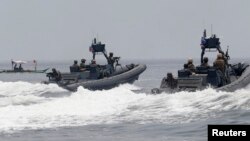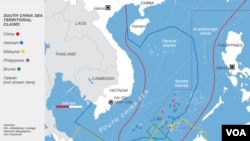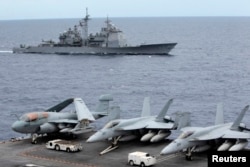MANILA —
The newly signed defense agreement between the Philippines and the United States is widely seen as a boost for the Philippines’ military at a time of increased tensions with China.
But analysts say the extent of U.S. support remains ambiguous, making it unclear how the pact might affect future confrontations between Manila and Beijing.
The so-called “Enhanced Defense Cooperation Agreement” will open Philippine bases to more U.S. troop visits, pave the way for additional bi-lateral military exercises and augment the Philippines information-gathering abilities at sea.
It also allows for U.S. forces to store vessels, aircraft and military equipment at select Philippine installations for the next 10 years.
Philippine Institute for Peace, Violence and Terrorism Research head Rommel Banlaoi says the training in sea surveillance will be crucial.
“Access to information in the maritime domain can help the Philippines avoid any accident in the sea, that might escalate tension in the South China Sea,” he said.
Banlaoi sees the maritime-related portions of the agreement as a boon for the country’s underfunded military as it prepares for conflicts in the heavily contested sea, seen by many as a serious potential flashpoint in Asia.
Maritime squabbling
The Philippines and China are squabbling over who owns outcroppings in the South China Sea. Manila has filed an international arbitration case questioning Beijing’s claims to practically the entire sea.
The Philippines says the contested rocks are well within its 370-kilometer exclusive economic zone. But Beijing says that based on ancient maps, it has “indisputable sovereignty over South China Sea islands and their adjacent waters.” It has rejected the arbitration case.
Brunei, Malaysia, Taiwan and Vietnam also have claims in the sea, which is abundant in marine life, believed to hold vast hydrocarbon reserves and is a major trade route.
Two years ago the two countries were in a months-long standoff at Scarborough Shoal, which is about 225 kilometers west of the Philippine province Zambales.
The encounter ended when Chinese surveillance ships permanently based themselves at the shoal, keeping local fishermen out.
Banlaoi says having maritime domain awareness skills will help the Philippines avoid such confrontations in the future.
The American military equipment could also come into play. According to the defense pact, although all of the prepositioned hardware will be for the exclusive use of American troops, it could be used to enhance both sides’ defense capabilities.
Unclear commitment
But it remains unclear under what circumstances U.S. forces in the region would come to the Philippines aid in the event of another confrontation in the South China Sea. Under their mutual defense treaty, the U.S. would defend the Philippines metropolitan area and its military if they are under threat of attack.
Security analyst Carl Thayer of the Australia Defense Force Academy says the Philippines expects some sort of deterrent by having American troops around.
“But deterrence only works if the party providing deterrence is willing to act.
Once the bluff is called and the U.S. doesn’t act, its credibility is undermined.
But the U.S. doesn’t want to put its credibility on [the line] for every barren rock on the South China Sea that’s contested, because it doesn’t take sides,” he said.
The United States has refrained from weighing in on the merits of various countries’ territorial claims in the South China Sea, saying it supports talks among the involved nations to resolve disputes.
Thayer says much of the territory at the heart of the dispute is likely not covered by the mutual defense treaty because it was signed in 1951, before the Philippines started laying claim to the reefs and rocks.
During President Barack Obama’s speech before a few hundred U.S. and Philippine troops in Manila Tuesday, he said America’s commitment to defend the Philippines is “ironclad.”
At the Philippines Peace, Violence and Terrorism Research institute, Banlaoi says Obama’s statement is true, as a matter of policy.
“But when it comes to operations, I don’t think it’s automatic. Because there is no automatic retaliation clause in the 1951 Mutual Defense Treaty,” he said.
Obama "Evasive"
Richard Heydarian, a Manila-based Asia geopolitical analyst, says President Obama remained “evasive” on whether that commitment would apply to an armed conflict in the contested sea and the Philippines should not assume Washington will intervene in the next standoff with China.
“Relying on America to push back China seems to be a not very viable option. And that is why the Aquino administration should be very careful in how it deals with China in the coming months.
Because after the Philippines decided to file the memorial on March 30th against China, the Chinese have been very much enraged,” he said.
China had a muted response to the signed defense agreement, calling on all sides to continue efforts to maintain peace and stability.
Representatives from the Chinese, Philippines and U.S. militaries are all expected to participate in RIMPAC (Rim of the Pacific) drills near Hawaii in July. It will mark the first time Chinese forces participate in the annual exercise.
But analysts say the extent of U.S. support remains ambiguous, making it unclear how the pact might affect future confrontations between Manila and Beijing.
The so-called “Enhanced Defense Cooperation Agreement” will open Philippine bases to more U.S. troop visits, pave the way for additional bi-lateral military exercises and augment the Philippines information-gathering abilities at sea.
It also allows for U.S. forces to store vessels, aircraft and military equipment at select Philippine installations for the next 10 years.
Philippine Institute for Peace, Violence and Terrorism Research head Rommel Banlaoi says the training in sea surveillance will be crucial.
“Access to information in the maritime domain can help the Philippines avoid any accident in the sea, that might escalate tension in the South China Sea,” he said.
Banlaoi sees the maritime-related portions of the agreement as a boon for the country’s underfunded military as it prepares for conflicts in the heavily contested sea, seen by many as a serious potential flashpoint in Asia.
Maritime squabbling
The Philippines and China are squabbling over who owns outcroppings in the South China Sea. Manila has filed an international arbitration case questioning Beijing’s claims to practically the entire sea.
The Philippines says the contested rocks are well within its 370-kilometer exclusive economic zone. But Beijing says that based on ancient maps, it has “indisputable sovereignty over South China Sea islands and their adjacent waters.” It has rejected the arbitration case.
Brunei, Malaysia, Taiwan and Vietnam also have claims in the sea, which is abundant in marine life, believed to hold vast hydrocarbon reserves and is a major trade route.
Two years ago the two countries were in a months-long standoff at Scarborough Shoal, which is about 225 kilometers west of the Philippine province Zambales.
The encounter ended when Chinese surveillance ships permanently based themselves at the shoal, keeping local fishermen out.
Banlaoi says having maritime domain awareness skills will help the Philippines avoid such confrontations in the future.
The American military equipment could also come into play. According to the defense pact, although all of the prepositioned hardware will be for the exclusive use of American troops, it could be used to enhance both sides’ defense capabilities.
Unclear commitment
But it remains unclear under what circumstances U.S. forces in the region would come to the Philippines aid in the event of another confrontation in the South China Sea. Under their mutual defense treaty, the U.S. would defend the Philippines metropolitan area and its military if they are under threat of attack.
Security analyst Carl Thayer of the Australia Defense Force Academy says the Philippines expects some sort of deterrent by having American troops around.
“But deterrence only works if the party providing deterrence is willing to act.
Once the bluff is called and the U.S. doesn’t act, its credibility is undermined.
But the U.S. doesn’t want to put its credibility on [the line] for every barren rock on the South China Sea that’s contested, because it doesn’t take sides,” he said.
The United States has refrained from weighing in on the merits of various countries’ territorial claims in the South China Sea, saying it supports talks among the involved nations to resolve disputes.
Thayer says much of the territory at the heart of the dispute is likely not covered by the mutual defense treaty because it was signed in 1951, before the Philippines started laying claim to the reefs and rocks.
During President Barack Obama’s speech before a few hundred U.S. and Philippine troops in Manila Tuesday, he said America’s commitment to defend the Philippines is “ironclad.”
At the Philippines Peace, Violence and Terrorism Research institute, Banlaoi says Obama’s statement is true, as a matter of policy.
“But when it comes to operations, I don’t think it’s automatic. Because there is no automatic retaliation clause in the 1951 Mutual Defense Treaty,” he said.
Obama "Evasive"
Richard Heydarian, a Manila-based Asia geopolitical analyst, says President Obama remained “evasive” on whether that commitment would apply to an armed conflict in the contested sea and the Philippines should not assume Washington will intervene in the next standoff with China.
“Relying on America to push back China seems to be a not very viable option. And that is why the Aquino administration should be very careful in how it deals with China in the coming months.
Because after the Philippines decided to file the memorial on March 30th against China, the Chinese have been very much enraged,” he said.
China had a muted response to the signed defense agreement, calling on all sides to continue efforts to maintain peace and stability.
Representatives from the Chinese, Philippines and U.S. militaries are all expected to participate in RIMPAC (Rim of the Pacific) drills near Hawaii in July. It will mark the first time Chinese forces participate in the annual exercise.














